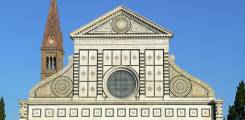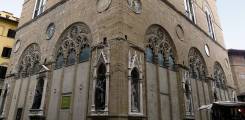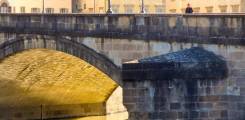We start with the medieval Church of Orsanmichele, the church, once a grain market represents the importance of the city’s trade guilds. Some of the guilds of the city commissioned statues for the church to understand the economics and commercial atmosphere of the city during the medieval time.
The statues, recently restored are now in display on the first floor of the church open only on Mondays and the museum is free of charge. It is worth entering the church to see the gothic marble tabernacle by Andrea Orcagna.
We continue then to the Church of Santa Croce where we will introduce the importance of the preaching orders in the medieval Florence: the Franciscans and the Domenicans. The Franciscans built the church and the piazza in the wool workers neighbourhood of the city, Santa Croce district.
Santa Croce is a church museum where you can admire the frescoes of private chapels of wealthy patrons. Giotto decorated the two most famous chapels of the church, the Bardi and the Peruzzi Chapels, it houses art-works by artists such as Cimabue, Brunelleschi with his Pazzi Chapel, Donatello and Della Robbia.
The church homes the tombs of the distinguished Italians such as: Michelangelo, Galileo Galilei, Machiavelli, Lorenzo Ghiberti and Rossini.
On the other side of the city the Dominicans, who were a militant order built another large basilica: Santa Maria Novella Church, a gothic basilica with vivid frescoes by Ghirlandaio and by Masaccio.
The fresco cycle of Mary and John the Baptist by Ghirlandaio is a brilliant composition which mirrors Florentine life in the late 15th century, the frescoes are like tableaux vivants, many of the figures are the artist’s contemporaries.
The other important fresco which seems a chapel, is the Trinity painted by Masaccio in 1426. It represents God the father supporting Jesus with the holy spirit depicted as a dove. The setting of the Trinity is a magnificent Renaissance chapel very similar to the architecture of his friend Brunelleschi.
Masaccio with this painting changed the history of western art, he was the first painter from the ancient times to represent man in nature. If you stand in front of the chapel you will find the “vanishing point” (where all the lines intersect) and you will enjoy the fascinating mathematical perspective.
Do not miss the visit to the old Pharmacy of Santa Maria Novella one of the oldest Pharmacies in the world, set up by the Dominican friars shortly after 1221, the year of their arrival in Florence. In the garden, the friars grew the herbs that they used to prepare medications, balms and creams for the monastery’s little infirmary.
In 1612 the Grand Duke gave the Dominicans permission to open this little store – the Pharmacy was opened to the public and their herbal secrets became internationally renowned. The essences, as well as the famous and much requested perfumes, pomades, spirits and liqueurs are still prepared to a large extent following the formulas studied in 1500 for Caterina de’ Medici.














